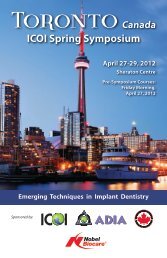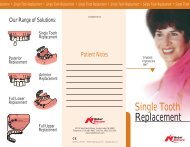Implant Consent Form - Advanced Periodontics & Implant Dentistry
Implant Consent Form - Advanced Periodontics & Implant Dentistry
Implant Consent Form - Advanced Periodontics & Implant Dentistry
Create successful ePaper yourself
Turn your PDF publications into a flip-book with our unique Google optimized e-Paper software.
have been drilled into the jawbone. The implants will have a snugly fit and will be held<br />
tightly in place during the healing phase. If I am a candidate, a minimally invasive<br />
approach may be used to place the implant. Depending upon the density of the bone,<br />
stability of the implants, and the doctor’s clinical judgment, teeth may be anchored<br />
immediately via the Smile In A Day TM or Teeth in an Hour TM procedure or the implants<br />
may be loaded at a future date. Later visits will involve the prosthodontic phase of my<br />
treatment which may involve several appointments.<br />
The gum and soft tissue will be stitched closed over or around the implants. Healing will<br />
ensue for a period of two to six months. I understand that dentures usually cannot be<br />
worn during the first two weeks of the healing phase. I further understand that if clinical<br />
conditions turn out to be unfavorable for the use of this implant system, or prevent the<br />
placement of implants, my dentist will use professional judgment as to the management of<br />
the situation. The procedures also may involve a supplemental bone graft or other types<br />
of graft materials to build up the ridge of my jaw, and thereby assist the placement,<br />
closure, and security of my implants. This may also include the placement of bone grafts<br />
into the maxillary sinuses to increase the height and width of bone for the appropriate<br />
insertion of implants for use as “back” teeth.<br />
After the surgery, there may be temporary pain, swelling, discoloration of the skin, and<br />
numbness or altered sensation. If sinus grafts are used, there may be nosebleeds.<br />
Post-Operative Exam: A post-operative examination will be required at regular intervals.<br />
For example:<br />
1. First or second week after surgery;<br />
2. Every four to eight weeks after surgery for three months.<br />
*Certain situations may require more/less frequent visits.<br />
Initial and Date _________________<br />
Post-Operative Sequelae: Typically, post operative healing is uneventful. However,<br />
certain situations may occur: pain around the implant fixture, infection, phobia, or change<br />
of mind by the patient. In addition, some tingling and loss of sensation in the area may<br />
occur when the implants are placed in the back of the lower jaw. In rare situations, this<br />
altered or loss of sensation may be permanent.<br />
Prognosis: While the prognosis is favorable at this time, the results cannot be<br />
guaranteed since unforeseen changes in the bone and soft tissue may occur which may<br />
require removal of the implant fixture. If an implant fixture does not join properly with<br />
the bone, it will be necessary to remove the implant in question. No problems are usually<br />
foreseen as a result of this removal.<br />
Second Surgical Procedure: For implants requiring a second surgical procedure, the<br />
overlaying tissues will be opened at the appropriate time, and the stability of the implant<br />
will be verified. If the implant appears satisfactory, an attachment will be connected to<br />
the implants. Plans and procedures to create an implant crown or appliance (by your<br />
general dentist or restorative dentist) can then begin after the gum tissue has healed.





